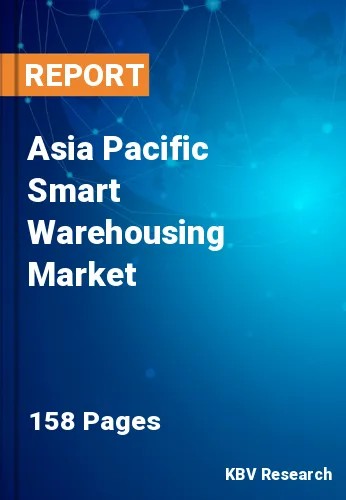The Asia Pacific Smart Warehousing Market would witness market growth of 12.1% CAGR during the forecast period (2022-2028).
The rising number of manual operations that can be automated can significantly reduce the requirement for employees to perform those duties. Additionally, with labor expenses on the rise, even lowering that number can help. Smart warehousing has another advantage in that it adds value to the work that employees are currently doing. When the processes under any industry occur faster, employees and business owners may accomplish more output in lesser time. Employees would be able to divert their attention to higher-value jobs as more manual tasks are automated, allowing them to optimize their current workforce. IoT-enabled warehouses can handle orders more quickly than manual warehouses, offering them a competitive edge. Instead of employing a typical first-in/first-out system, for instance, if duties can be efficiently automated to ensure that the most urgent client demands are prioritized, the customer experience can be considerably improved. Warehousing might therefore be introduced as a value-added service to the organization's overall offering.
To improve efficiency and customer experience, technology-based smart warehousing is becoming increasingly popular in India, China, South Korea, Singapore, and other countries. In addition, the region is likely to observe an increase in the adoption of smart warehousing hardware, solutions, & services.
Moreover, due to the rapid technological advancement and the growing automotive industry, the region is estimated to witness relatively higher demand for more efficient warehousing techniques. Further, developing countries across the region are focusing on air freight centers in order with a significant storage in order to offer increased capacities to various government organizations. Deploying smart warehousing technologies across these warehouses would save considerable amount of time along with providing better stocking capabilities to these regional organizations.
The China market dominated the Asia Pacific Smart Warehousing Market by Country in 2021, and would continue to be a dominant market till 2028; thereby, achieving a market value of $2,423.3 million by 2028. The Japan market is anticipated to grow at a CAGR of 11.4% during (2022 - 2028). Additionally, The India market is would showcase a CAGR of 12.8% during (2022 - 2028).
Based on Deployment Mode, the market is segmented into On-premises and Cloud. Based on Technology, the market is segmented into Automated Guided Vehicles (AGV), IoT & Analytics, RFID, AI in Warehouse, Blockchain & Others. Based on Application, the market is segmented into Transport Management, Inventory & Order Management, Yard & Shipping Management, Labour Management, and Others. Based on Component, the market is segmented into Hardware, Solution (Warehouse Management Systems and Warehouse Control Systems & Others), and Services. Based on Organization Size, the market is segmented into Large Enterprises and Small & Medium Enterprises (SMEs). Based on Vertical, the market is segmented into Transportation & Logistics, Retail & Consumer Goods, Automotive, Government, Healthcare & Life Sciences, Manufacturing, Mining, Food & Beverages, and Others. Based on countries, the market is segmented into China, Japan, India, South Korea, Singapore, Malaysia, and Rest of Asia Pacific.
Free Valuable Insights: The Worldwide Smart Warehousing Market is Projected to reach USD 29 Billion by 2028, at a CAGR of 11.2%
The market research report covers the analysis of key stake holders of the market. Key companies profiled in the report include IBM Corporation, Oracle Corporation, SAP SE, Infor, Inc., Softeon, Körber AG, Manhattan Associates, Inc., PTC, Inc., Tecsys, Inc., and Epicor Software Corporation.
By Deployment Mode
By Technology
By Application
By Component
By Organization Size
By Vertical
By Country
Our team of dedicated experts can provide you with attractive expansion opportunities for your business.

